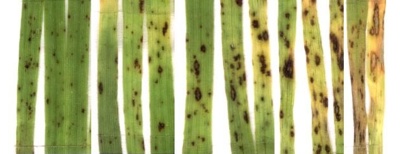Diseases
Cochliobolus sativus (Ito et Kurib.) Drechsler ex Dastur. [anamorph Bipolaris sorokiniana (Sacc.) Shoemaker] - Wheat Leaf Spot Blotch.
Systematic position.
Class Hyphomycetes, order Hyphomycetales, family Dematiaceae, genus Bipolaris.Synonym.
Helminthosporium sativum Pammel, C.M. King et BakkeBiological group.
Hemibiotrophic parasite.Morphology and biology.
Fungus infects young leaves by direct penetration into epidermis or through stomata. C. sativus produces distinct elongate brown-black lesions (spot-blotch) that rarely exceed 1 cm in length. The blotchy lesions contrast sharply with green or leaf tissue. Primary infections occur on coleoptiles, primary roots, and subcrown internodes. Secondary conidia develop on the above-ground parts of plant. They disperse by wind and initiate lesions on leaves and culms. Leaf symptoms are obvious after heading and most frequent on lower leaves. After penetration the mycelia grow in the leaf tissues as inter- and intra-cellular infection. Mycelium is deep olive-brown, septated. Conidiophores emerge through stomata, less frequently directly between epidermal cells. Conidiophores are deep olive-brown, erect, single or clustered, 50.150 x 6.0.8.5 .m, septate. Conidia are deep olive or olive-brown, ovate to oblong, erect or slightly curved, 30-134 x 12.30 .m, with 2.13 septae. They germinate by two polar cells. The perfect stage is rarely found. Pseudothecia are dark-brown, bottle-shaped or globose, 300.400 .m in diameter. Asci are numerous, spindle-shaped or cylindrical with a short peduncle, 110.220 x 32.45.m, contain 1.8 (more often 4.8) ascospores. Ascospores filamentous and spirally flexed within asci, 6.14 septate, hyaline or slightly yellowish, 160.360 x 6.0.9.0 .m. Fungus persists in abundance as mycelium and conidia principally. In the summer period the fungus develops in conidia stage.Distribution.
The fungus is a cosmopolitan, it infects wild-growing and cultural cereals including wheat, barley, oat, and rye. It meets everywhere in area of cereal growing. In Russia the Wheat Spot Blotch has been found out in the Non-Chernozem zone, European Northeast, Ural, and Eastern Siberia. Disease development is weak. Presence of the disease is marked in the Samara and Orenburg Regions. The disease meets in the Kokshetau, Qostanay and North-Kazakhstan Regions of Kazakhstan.Ecology.
Wheat Spot Blotch usually meets in warm and damp districts. Optimum temperature for the fungus growth is 27.28.C, minimal . 10.C, maximal 29.C; optimum for conidia formation is 16 . 25.C. Light accelerates conidia formation. Mycelium and conidia survive at temperature 32 . 33.C. Optimum humidity ratio of a substratum for the fungus development is 60 - 80%; optimum pH is 6 - 7. The maximal infection of overground plant organs occurs at temperature higher than 15.C and relative humidity of air 95 - 97%. C. sativus overwinters as mycelium and conidia on plant debris and on grain. In conditions of a droughty climate C. sativus conidia are kept in ground to 5 years.Economic significance.
Grain yield losses due to the Spot Blotch reach 24-27 % in highly susceptible cultivars (disease severity is 80% and higher). The loss of grain yield of the resistant cultivar reaches 3.4%, and those of the most susceptible ones reaches 25.6%. In 1980 on cultivar Kharkovskaya 46 the disease development in the Qostanay Region reached 43.8% in phase of milk-dough development, and 14.3% in 1982. In other areas of the former USSR weak development of the disease was observed. Thus, the Northern Kazakhstan is a zone of the highest severity of Spot Blotch. Development of Leaf Spot Blotch results in black grain germ amplification that reduces grain quality and germination.Related references.
Bhandari, D., Bhatta, M.R., Duvellier, E., & Shrestha, S.M. 2003. Foliar blight of wheat in Nepal: resistance breeding, epidemiology and disease management. Proceedings of the Fourth International Wheat Tan Spot and Spot Blotch Workshop. July 21-24, 2002. Eds. J.B. Rasmussen, T.L. Friesen, & S. Ali. NDSU, Fargo. з.145-150.Khasanov, B.A. 1992. Keys to fungi . causal agents of Helminthosporium diseases of Bipolaris, Drechslera and Exserohilum species. Tashkent: FAN, 243 p. (in Russian).
Khasanov, B.A. 1988. Yellow leaf spot of cereals caused by Pyrenophora-tritici-repentis (Died.) Drechs. Mikologiya i Fitopatologiya 22 (1). P. 78 . 83 (in Russian)
Peresypkin, V.F. 1981, Atlas of diseases of crop cultures. Kiev: Urozhaj, 248 p. (in Russian)
Rassadina, E.G. 1973. Leaf spot blights of cereals. In: Distribution of diseases of agricultural crops in the USSR in 1968 . 1972. Leningrad: VIZR. p.40 . 41 (in Russian).
Rudakov, O.V, Titova, K.D., Pospekhov, G.V., & Fissura, N.I. 1989. Zones of harmfulness of leaf spot blotches pathogens. Collection of scientific works of Mironovsk science-research institute of wheat breeding and seeds production: Increasing of productiveness and stability of winter wheat yields production in USSR. Mironovka. p.134-39 (in Russian).
Sharma, R.C., Gyawali, S., Shrestha, S., Chaudhary, N.K., & Duveiller, E. 2003. Field resistance to Helminthosporium leaf blight in wheat genotypes from diverse origins. Proceedings of the Fourth International Wheat Tan Spot and Spot Blotch Workshop. July 21-24, 2002. Eds. J.B. Rasmussen, T.L. Friesen, & S. Ali. NDSU, Fargo. P.145-150.
Tupenevich, S.M. 1970. Root rot of spring wheat in droughty areas of North Kazakhstan and steppe areas of Western Siberia. In: Peresypkin, V.F. ed. Root rot of grain cereals and measures of struggle against them. Moscow: Kolos, p. 3 . 8 (in Russian)
Tupenevich, S.M., & Nesterov, A.N. 1977. Agronomical methods in protection of spring wheat against root rot in Northern Kazakhstan. In: Proc. VIZR, Isssue 56, P. 41.61 (in Russian)
Wiese, M.V. 1977. Compendium of wheat diseases. American Phytopathological Society. USA. 106 p.
Zdrazhevskaya, S.D. 1985. Ways of rational fungicide use against complex of aerogenic infection of spring wheat. In: Chemical method of protection of agricultural plants from fungus diseases. Leningrad; VIZR. P. 64 . 70 (in Russian)
Zdrazhevskaya, S.D., & Shugurov, I.M. 1991. Features of protection of spring durum wheat during vegetation from complex of diseases. In: Problems of protection of grain crops from Fusarium and other diseases, Minsk, p. 97-106 (in Russian).
© Mikhailova L.A.


